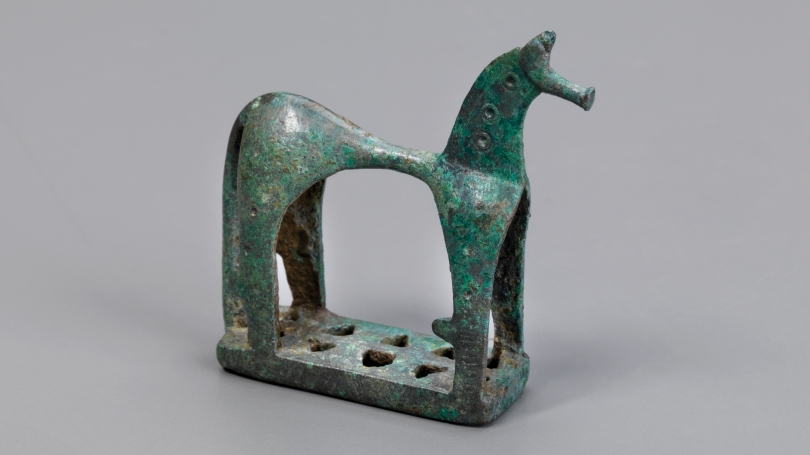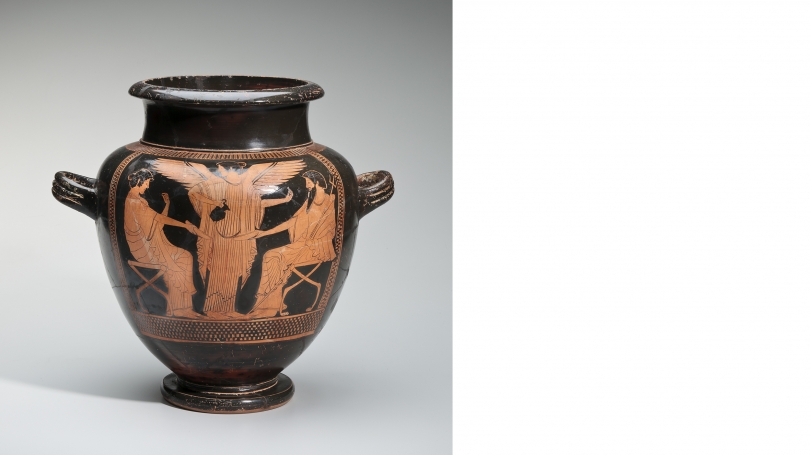This winter the Hood Museum of Art will showcase the first major US museum exhibition to focus on the ancient Greek god Poseidon and his relationship to the sea. The art on display will illuminate how ancient societies in the Mediterranean world worshipped this powerful god, who wielded immense authority through his dominion over the sea, as well as over horses and diverse natural phenomena. Included in this rich and focused exhibition are ancient vases decorated with mythological scenes, as well as objects that demonstrate observance of cult worship of the god—Poseidon for the Greeks, Nethuns and Neptune for the Etruscans and Romans, respectively—and aspects of daily life across the ancient Mediterranean.
Poseidon and the Sea has been curated by Dartmouth alumnus Seth Pevnick, Class of 1999, who is acting director, chief curator, and Richard E. Perry Curator of Greek and Roman Art at the Tampa Museum of Art, as well as a former Hood Museum of Art intern. Dr. Pevnick was inspired to organize a show on this topic by the nearly lifesized marble statue of the god from the Tampa collection, which presides at the entrance of the exhibition. "I will always remain grateful to Dartmouth and the Hood Museum for providing me with the opportunity, as an undergraduate, to work directly with antiquities. It was there that I took my first steps towards a museum career, and it is truly gratifying now to help bring an antiquities exhibition there," said Pevnick. "Poseidon and the Sea has been well received in Tampa and at the Joslyn Art Museum in Omaha, and I look forward to seeing the installation in Hanover, where we will be able to incorporate a highlight from the Hood's permanent collection. I hope that these and the other objects on view will be a benefit to students and professors in multiple departments, from Classics and Art History to Studio Art and beyond."
Featuring over 110 works from major public and private collections in the United States and Europe, Poseidon and the Sea examines not only the myth of Poseidon and his place among the gods but also a range of religious cults and the types of votive objects dedicated to this god and related divinities, as well as the myriad ways in which daily life in the ancient Mediterranean world was tied to the sea. Among the objects illustrating the latter are elaborately decorated fish plates (cover) that show the bounty of the sea.
Instantly recognizable by his trident and accompanied by fish and dolphins, Poseidon—like his Roman counterpart Neptune—is characterized by his sturdy build, thick wavy hair, and full beard. He looms large in Greek mythology as a central figure in the battle between the Olympian gods that brought order to the world and the monstrous race of Giants that threatened to overthrow them and create havoc. With power over not only the sea but also horses and natural phenomena from floods to earthquakes, Poseidon carried great importance throughout the ancient world. His most famous sanctuary was fat Isthmia, where the Peloponnesos joins the Greek mainland, but he was also worshipped at landlocked sanctuaries. Votive offerings—from a small bronze horse, to schools of lead fish, to representations of the god himself—were meant to illuminate and impress. The exhibition includes a monumental bronze trident from the J. Paul Getty Museum that is over a dozen feet long and believed to have accompanied a colossal statue of the god that is now lost.
Beyond mythology and religion, however, the sea was the center of daily life in towns and cities along the coast of the Mediterranean. It provided food and other resources, and allowed for easy travel and trade. Allusions to the sea are found throughout ancient art, from cargo boats and warships to dolphins, fish, and octopi. Visitors to the exhibition will discover illustrations of fishermen and shipbuilders alongside fish hooks and ship models, blurring the line between art and artifact, bringing the world of antiquity to life, and offering an intimate look at the timeless beauty and wonder of the sea that continues to resonate with us in the present day.
The works of art and material culture in the exhibition date to between 800 BCE and 400 CE, and were created by ancient Greek, Etruscan, and Roman artists and artisans. They include striking black-figure and red-figure pottery; sculptures in terracotta, marble, and precious metals; and extraordinary examples of ancient glass, mosaics, carved gems, and coins, all providing a rich picture of life in the ancient world.
Dr. Pevnick has edited a richly illustrated catalogue, with essays by several leading scholars, accompanying the exhibition. In conjunction with the exhibition, he will give an introductory lecture at 5:00 p.m. on Friday, January 30, followed the next day by a half-day symposium from 10:00 to noon, featuring talks by scholars who have been working on topics related to the themes of the exhibition. Dr. Brendan Foley, resident archaeologist at the Woods Hole Oceanographic Institution, will give a lecture on the underwater archaeology at the site of an ancient shipwreck off the Greek island of Antikythera on January 16 at 5:00 p.m. in the Hood Museum of Art Auditorium.
This exhibition was organized by the Tampa Museum of Art and will be on view at the Hood from January 17 through March 15, 2015. Its presentation at the Hood Museum of Art was generously supported by Claire Foerster and Daniel S. Bernstein, Class of 1987, and the Eleanor Smith Fund, the Evelyn A. J. Hall Fund, and the Marie-Louise and Samuel R. Rosenthal Fund.
![Roman (after Classical Greek original), statue of Poseidon/Neptune alongside dolphin, 1st century CE (Flavian [69–96 CE]?), marble. Tampa Museum of Art, Joseph Veach Noble Collection 1986.135. Roman (after Classical Greek original), statue of Poseidon/Neptune alongside dolphin, 1st century CE (Flavian [69–96 CE]?), marble. Tampa Museum of Art, Joseph Veach Noble Collection 1986.135.](https://hoodmuseum.dartmouth.edu/sites/hoodmuseum.prod/files/styles/slide/public/hoodmuseum/images/statue_of_poseidon_edit.jpg?itok=y4wss_zb)

